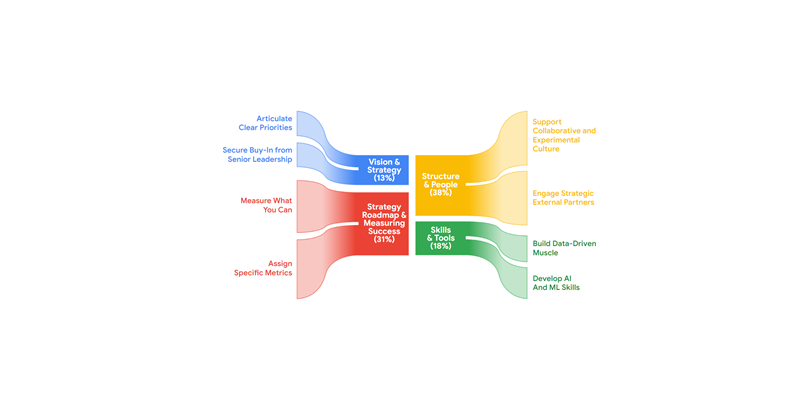Building a future-ready organisation is no longer only about investing in digital technology. Digital transformations are rooted and led through people transformation. Though implementing tech solutions is critical to keep up in the ever-changing market, today’s leading companies demonstrate that out-performing competitors requires a more holistic approach to digital transformation.
Google and Kantar partnered over the summer of 2021 to explore what today’s leading companies do differently to drive revenue growth and digital transformation success. We spoke to 40 Fortune 1000 C-suite members from a range of industries and surveyed 500 senior- to mid-level marketers from large organisations across the United States. From that work we identified four primary areas for driving revenue growth relative to competitors: Strategy, Structure, People and Tools. By focusing on refining these core tenets of organisational excellence, organisations at any level of digital maturity can succeed.

As outlined by this framework, each focus area contributes varying levels of impact on overall revenue growth (depicted by the %), but ultimately, leading companies over-perform on drivers within all four. Utilize this framework to create a holistic transformation approach incorporating each unique component for the greatest impact on your organisation’s business performance.
Step 1: Vision & strategy
Articulate clear priorities with clearly defined success metrics and secure buy-in from senior leadership, including active support from the board.
There can be no room left for doubt about the strategic choices the company is making, and setting clear objectives related to those decisions from the outset ensures people at all levels, and across all teams, understand the vision for growth and their role in it. We explored why having the right leaders is critical to your digital marketing transformation more in depth earlier this year based off the same research.
Senior leaders across the organisation must buy-in and champion growth initiatives for digital marketing capabilities. Critical to this endeavor is the active participation of senior stakeholders, including the board.
The role of the board has shifted significantly in recent years. C-suites of leading organisations are guided by boards with three key attributes:
- Active functional expertise (not yet retired)
- Diversity of expertise areas
- Readiness to spar with C-suite leaders in strategic decision-making
Board members with extensive first-hand knowledge will help push an organisation’s transformation agenda, ensuring it is led with a well-informed and current perspective. Instead of providing the wisdom of retirees, today’s core role of a board is to challenge the ambition and innovation strategies of the C-suite.
Step 2: Measuring success
Measure what you can for your marketing efforts and translate the business impact of that progress into financial metrics, holistically.
Leading organisations learn constantly by measuring as much as possible, rethinking the role of marketing as a constant source of information from the voice of the customer.
Assign metrics to gauge the effectiveness of campaigns, platforms, touchpoints, annual marketing plans, media channels, and individual executions, alike. This will ultimately build a wealth of learning on which to build in the future.
Assign specific owners for measuring effectiveness. It is not just what you measure but who is responsible and accountable for the measurement. Having qualified minds accountable for the measurement of marketing efforts is just as important as ensuring those initiatives are explicitly mapped to business outcomes.
Integrate the metrics of each marketing effort–from annual marketing plans to individual executions–into the P&L and ensure the financial impact of those activities is clear to all functions and stakeholders. This then shifts the marketing team’s value proposition to the actual ROI of each effort, rather than the assumed value of a sheer number of efforts.
Step 3: Structure & people
Successful digital transformation requires an org structure with more nimble approaches to learning, leading and leveraging the change initiatives. To expedite an organisation’s transformation, it is critical to facilitate internal cross-collaboration and experimentation, and balance internal roles with the right strategic partners.
Fostering a culture of experimentation must be championed by leadership. Encourage collaboration between functions, and revisit those shared metrics for success that we discussed earlier.
Cross-functional collaboration also has an impact on efficiencies. It’s no longer a ‘nice to have,’ it’s an imperative. By building trust and confidence through the fail/scale fast approach, teams can more readily identify their capability and knowledge gaps.
Engage external strategic partners to push your internal teams to become agile and digitally savvy, and select external partners with intention. Choose companies that bring new tech solutions and specific functional expertise to help grow your business and your credibility.
Step 4: Skills & tools
Once the organisational elements of Strategy, Structure, People & Processes are in place, it is time to (re)invest in tech tools. But to realize this ROI, digital capability building must be a priority.
Certain hard skills will always be valued within each function, and soft skills will continue to differentiate talent, but when it comes to increasing digital maturity, organisations must have strong digital marketing operations and focus on capability building, particularly integrated data science and data analytics.
Building data-driven muscle is a huge opportunity for growth for most organisations. Nine out of 10 marketers we spoke to agree that it is important to continue improving your company’s digital marketing capabilities and resources. Yet, only 29% of marketers report that it is common to have data science and data analytics capabilities. Hire a future fit marketing team that requires skills that finance teams typically recruit for: intellectual curiosity and skills that go beyond purely technical functions.
The final growth driver of focus is a longer-term development of AI and ML skills. While establishing the people elements is imperative to growth, we cannot discount the impact of the sophistication of tech as a major factor in growth. Utilizing artificial intelligence and machine learning offers huge opportunities for business growth, particularly due to their impact on the depth and efficiency of marketing measurement. Being able to measure the lifetime value of the most profitable customers or overall growth segments by leveraging data infrastructure informs business strategy. Hire marketers with data analytics skills, and more broadly, begin building a culture of curiosity and experimentation to ensure team members are motivated and rewarded for developing future-fit capabilities.
Our growth drivers framework is the key to understanding how to embody a leading organisation. Today’s high performers extend transformation initiatives beyond just tech investments; they understand that change requires a cohesive, organisation-wide transformation of the strategy, structure, people and tools.
While digital transformation initiatives are measured through the success of new marketing efforts and implementing new digital tools more effectively, they are first and foremost about embracing change in Strategy, Structure, People and Tools. Successful growth initiatives are highly dependent on having upfront clarity on the vision and strategy, and the right people and mindset for growth modeled by senior leaders and the board, alike. Setting up the whole organisation for success is the ultimate growth driver, and that requires a balance of all four areas.


